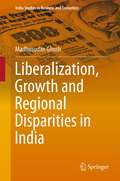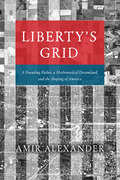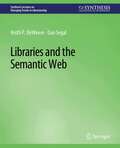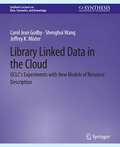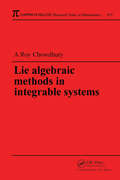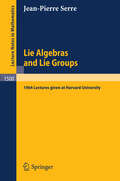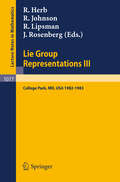- Table View
- List View
Liber Mahameleth: A 12th-century Mathematical Treatise (Sources and Studies in the History of Mathematics and Physical Sciences)
by Jacques SesianoThe Liber mahameleth is a work in Latin written in the mid-12th century based (mainly) on Arabic sources from Islamic Spain. It is now our principal source on mathematics in Islamic Spain at that time; There are few extant Arabic texts and no one is as complete as the LM. It is also the second largest mathematical work from the Latin Middle Ages (the other is by Fibonacci, some 50 years later).Since the three main manuscripts preserving it are incomplete and there are many scribal errors, a reliable Latin text has been established, which reports (in notes) the various readings of the manuscripts and the errors in them. This is how a so-called critical edition is made. This edition of the Latin text is preceded by General Introduction, describing the various manuscripts, the content of the work and what we know about its author.Part Two of the volume is a translation of the text and ends with a glossary of Latin terms. The glossary will be of great importance for the knowledge of Latin scientific terms from that time, since there is no other mathematical text of this size from the 12th century. Part Three begins with a short introduction and then analyzes all the problems from the text, with a summary of the mathematical methods involved in each chapter. The commentary is a companion to the translation and explains the author's solving methods.
Liberalization, Growth and Regional Disparities in India (India Studies in Business and Economics)
by Madhusudan GhoshUpon the backdrop of impressive progress made by the Indian economy during the last two decades after the large-scale economic reforms in the early 1990s, this book evaluates the performance of the economy on some income and non-income dimensions of development at the national, state and sectoral levels. It examines regional economic growth and inequality in income originating from agriculture, industry and services. In view of the importance of the agricultural sector, despite its declining share in gross domestic product, it evaluates the performance of agricultural production and the impact of agricultural reforms on spatial integration of food grain markets. It studies rural poverty, analyzing the trend in employment, the trickle-down process and the inclusiveness of growth in rural India. It also evaluates the impact of microfinance, as an instrument of financial inclusion, on the socio-economic conditions of rural households. Lastly, it examines the relative performance of fifteen major states of India in terms of education, health and human development. An important feature of the book is that it approaches these issues, applying rigorously advanced econometric methods, and focusing primarily on their regional disparities during the post-reform period vis-à-vis the pre-reform period. It offers important results to guide policies for future development.
Liberty's Grid: A Founding Father, a Mathematical Dreamland, and the Shaping of America
by Amir AlexanderThe surprising history behind a ubiquitous facet of the United States: the gridded landscape. Seen from an airplane, much of the United States appears to be a gridded land of startling uniformity. Perpendicular streets and rectangular fields, all precisely measured and perfectly aligned, turn both urban and rural America into a checkerboard landscape that stretches from horizon to horizon. In evidence throughout the country, but especially the West, the pattern is a hallmark of American life. One might consider it an administrative convenience—an easy way to divide land and lay down streets—but it is not. The colossal grid carved into the North American continent, argues historian and writer Amir Alexander, is a plan redolent with philosophical and political meaning. In 1784 Thomas Jefferson presented Congress with an audacious scheme to reshape the territory of the young United States. All western lands, he proposed, would be inscribed with a single rectilinear grid, transforming the natural landscape into a mathematical one. Following Isaac Newton and John Locke, he viewed mathematical space as a blank slate on which anything is possible and where new Americans, acting freely, could find liberty. And if the real America, with its diverse landscapes and rich human history, did not match his vision, then it must be made to match it. From the halls of Congress to the open prairies, and from the fight against George III to the Trail of Tears, Liberty’s Grid tells the story of the battle between grid makers and their opponents. When Congress endorsed Jefferson’s plan, it set off a struggle over American space that has not subsided. Transcendentalists, urban reformers, and conservationists saw the grid not as a place of possibility but as an artificial imposition that crushed the human spirit. Today, the ideas Jefferson associated with the grid still echo through political rhetoric about the country’s founding, and competing visions for the nation are visible from Manhattan avenues and Kansan pastures to Yosemite’s cliffs and suburbia’s cul-de-sacs. An engrossing read, Liberty’s Grid offers a powerful look at the ideological conflict written on the landscape.
Liberty's Grid: A Founding Father, a Mathematical Dreamland, and the Shaping of America
by Amir AlexanderThe surprising history behind a ubiquitous facet of the United States: the gridded landscape. Seen from an airplane, much of the United States appears to be a gridded land of startling uniformity. Perpendicular streets and rectangular fields, all precisely measured and perfectly aligned, turn both urban and rural America into a checkerboard landscape that stretches from horizon to horizon. In evidence throughout the country, but especially the West, the pattern is a hallmark of American life. One might consider it an administrative convenience—an easy way to divide land and lay down streets—but it is not. The colossal grid carved into the North American continent, argues historian and writer Amir Alexander, is a plan redolent with philosophical and political meaning. In 1784 Thomas Jefferson presented Congress with an audacious scheme to reshape the territory of the young United States. All western lands, he proposed, would be inscribed with a single rectilinear grid, transforming the natural landscape into a mathematical one. Following Isaac Newton and John Locke, he viewed mathematical space as a blank slate on which anything is possible and where new Americans, acting freely, could find liberty. And if the real America, with its diverse landscapes and rich human history, did not match his vision, then it must be made to match it. From the halls of Congress to the open prairies, and from the fight against George III to the Trail of Tears, Liberty’s Grid tells the story of the battle between grid makers and their opponents. When Congress endorsed Jefferson’s plan, it set off a struggle over American space that has not subsided. Transcendentalists, urban reformers, and conservationists saw the grid not as a place of possibility but as an artificial imposition that crushed the human spirit. Today, the ideas Jefferson associated with the grid still echo through political rhetoric about the country’s founding, and competing visions for the nation are visible from Manhattan avenues and Kansan pastures to Yosemite’s cliffs and suburbia’s cul-de-sacs. An engrossing read, Liberty’s Grid offers a powerful look at the ideological conflict written on the landscape.
Libraries and the Semantic Web (Synthesis Lectures on Emerging Trends in Librarianship)
by Keith P. DeWeese Dan SegalThis book covers the concept of the Semantic Web—what it is, the components that comprise it, including Linked Data, and the various ways that libraries are engaged in contributing to its development in making library resources and services ever more accessible to end-users.
Library Linked Data in the Cloud: OCLC's Experiments with New Models of Resource Description (Synthesis Lectures on Data, Semantics, and Knowledge)
by Carol Jean Godby Shenghui Wang Jeffrey MixterThis book describes OCLC's contributions to the transformation of the Internet from a web of documents to a Web of Data. The new Web is a growing `cloud' of interconnected resources that identify the things people want to know about when they approach the Internet with an information need. The linked data architecture has achieved critical mass just as it has become clear that library standards for resource description are nearing obsolescence. Working for the world's largest library cooperative, OCLC researchers have been active participants in the development of next-generation standards for library resource description. By engaging with an international community of library and Web standards experts, they have published some of the most widely used RDF datasets representing library collections and librarianship. This book focuses on the conceptual and technical challenges involved in publishing linked data derived from traditional library metadata. This transformation is a high priority because most searches for information start not in the library, nor even in a Web-accessible library catalog, but elsewhere on the Internet. Modeling data in a form that the broader Web understands will project the value of libraries into the Digital Information Age. The exposition is aimed at librarians, archivists, computer scientists, and other professionals interested in modeling bibliographic descriptions as linked data. It aims to achieve a balanced treatment of theory, technical detail, and practical application.
Lichtspiele in der Luft: Atmosphärische Optik für Einsteiger
by Michael VollmerWir haben tagtäglich die atmosphärische Optik vor Augen - und übersehen sie geflissentlich. Dabei führt uns der Himmel anschaulich vor, was mit dem Licht passiert, wenn es an Wassertropfen oder Rauch gestreut wird und dort, wo eigentlich nichts ist als mehr oder weniger reine Luft, bunte Bilder an den Himmel zaubert. Sonnenuntergänge, Regenbögen, Polarlichter, Aureolen und Glorien - eine Art Hof oder Heiligenschein - oder Fata morganas werden in Michael Vollmers reich illustriertem und klar verständlichem Buch zum natürlichen Labor für physikalische Entdeckungen - und man wird staunen, wie viel Physik man plötzlich kann - und die ist keine Fata Morgana.
The Lidov-Kozai Effect - Applications in Exoplanet Research and Dynamical Astronomy (Astrophysics and Space Science Library #441)
by Ivan I. ShevchenkoThis book deals with an effect in celestial mechanics that has become quite important in exoplanet research. The Lidov-Kozai effect reveals itself in coherent periodic variations (which can be very large) of the inclination and eccentricity of an orbiting body in the presence of an inclined perturber. The effect is known to be important in the motion of many asteroids and planetary satellites. What is more, now it attracts more and more interest in the astronomical and astrophysical community due to its relevance for many exoplanetary systems. Recent years witnessed major advancements in its theory. It would be no exaggeration to say that nowadays the Lidov-Kozai effect becomes one of the most studied astrophysical effects. This book covers the multitude of the Lidov-Kozai effect’s modern applications and its theory developments. It will be useful for researchers and students working in astrophysics, celestial mechanics, stellar dynamics, theoretical mechanics, space missions design, depending on the interests of the reader. The book is self-contained. It provides the full detailed coverage of the effect’s theory and applications.
Lie Algebraic Methods in Integrable Systems
by Amit K. Roy-ChowdhuryOver the last thirty years, the subject of nonlinear integrable systems has grown into a full-fledged research topic. In the last decade, Lie algebraic methods have grown in importance to various fields of theoretical research and worked to establish close relations between apparently unrelated systems. The various ideas associated with Lie algebra and Lie groups can be used to form a particularly elegant approach to the properties of nonlinear systems. In this volume, the author exposes the basic techniques of using Lie algebraic concepts to explore the domain of nonlinear integrable systems. His emphasis is not on developing a rigorous mathematical basis, but on using Lie algebraic methods as an effective tool.The book begins by establishing a practical basis in Lie algebra, including discussions of structure Lie, loop, and Virasor groups, quantum tori and Kac-Moody algebras, and gradation. It then offers a detailed discussion of prolongation structure and its representation theory, the orbit approach-for both finite and infinite dimension Lie algebra. The author also presents the modern approach to symmetries of integrable systems, including important new ideas in symmetry analysis, such as gauge transformations, and the "soldering" approach. He then moves to Hamiltonian structure, where he presents the Drinfeld-Sokolov approach, the Lie algebraic approach, Kupershmidt's approach, Hamiltonian reductions and the Gelfand Dikii formula. He concludes his treatment of Lie algebraic methods with a discussion of the classical r-matrix, its use, and its relations to double Lie algebra and the KP equation.
Lie Algebraic Methods in Integrable Systems
by Amit K. Roy-ChowdhuryOver the last thirty years, the subject of nonlinear integrable systems has grown into a full-fledged research topic. In the last decade, Lie algebraic methods have grown in importance to various fields of theoretical research and worked to establish close relations between apparently unrelated systems. The various ideas associated with Lie algebra and Lie groups can be used to form a particularly elegant approach to the properties of nonlinear systems. In this volume, the author exposes the basic techniques of using Lie algebraic concepts to explore the domain of nonlinear integrable systems. His emphasis is not on developing a rigorous mathematical basis, but on using Lie algebraic methods as an effective tool.The book begins by establishing a practical basis in Lie algebra, including discussions of structure Lie, loop, and Virasor groups, quantum tori and Kac-Moody algebras, and gradation. It then offers a detailed discussion of prolongation structure and its representation theory, the orbit approach-for both finite and infinite dimension Lie algebra. The author also presents the modern approach to symmetries of integrable systems, including important new ideas in symmetry analysis, such as gauge transformations, and the "soldering" approach. He then moves to Hamiltonian structure, where he presents the Drinfeld-Sokolov approach, the Lie algebraic approach, Kupershmidt's approach, Hamiltonian reductions and the Gelfand Dikii formula. He concludes his treatment of Lie algebraic methods with a discussion of the classical r-matrix, its use, and its relations to double Lie algebra and the KP equation.
Lie Algebras: Madison 1987. Proceedings of a Workshop held in Madison, Wisconsin, August 23-28, 1987 (Lecture Notes in Mathematics #1373)
by Georgia Benkart J. Marshall OsbornDuring the academic year 1987-1988 the University of Wisconsin in Madison hosted a Special Year of Lie Algebras. A Workshop on Lie Algebras, of which these are the proceedings, inaugurated the special year. The principal focus of the year and of the workshop was the long-standing problem of classifying the simple finite-dimensional Lie algebras over algebraically closed field of prime characteristic. However, other lectures at the workshop dealt with the related areas of algebraic groups, representation theory, and Kac-Moody Lie algebras. Fourteen papers were presented and nine of these (eight research articles and one expository article) make up this volume.
Lie Algebras and Algebraic Groups (Springer Monographs in Mathematics)
by Patrice Tauvel Rupert W. YuDevoted to the theory of Lie algebras and algebraic groups, this book includes a large amount of commutative algebra and algebraic geometry so as to make it as self-contained as possible. The aim of the book is to assemble in a single volume the algebraic aspects of the theory, so as to present the foundations of the theory in characteristic zero. Detailed proofs are included, and some recent results are discussed in the final chapters.
Lie Algebras and Applications (Lecture Notes in Physics #891)
by Francesco IachelloThis course-based primer provides an introduction to Lie algebras and some of their applications to the spectroscopy of molecules, atoms, nuclei and hadrons. In the first part, it concisely presents the basic concepts of Lie algebras, their representations and their invariants. The second part includes a description of how Lie algebras are used in practice in the treatment of bosonic and fermionic systems. Physical applications considered include rotations and vibrations of molecules (vibron model), collective modes in nuclei (interacting boson model), the atomic shell model, the nuclear shell model, and the quark model of hadrons. One of the key concepts in the application of Lie algebraic methods in physics, that of spectrum generating algebras and their associated dynamic symmetries, is also discussed. The book highlights a number of examples that help to illustrate the abstract algebraic definitions and includes a summary of many formulas of practical interest, such as the eigenvalues of Casimir operators, and the dimensions of the representations of all classical Lie algebras.For this new edition, the text has been carefully revised and expanded; in particular, a new chapter has been added on the deformation and contraction of Lie algebras.From the reviews of the first edition:"Iachello has written a pedagogical and straightforward presentation of Lie algebras [...]. It is a great text to accompany a course on Lie algebras and their physical applications."(Marc de Montigny, Mathematical Reviews, Issue, 2007 i)"This book [...] written by one of the leading experts in the field [...] will certainly be of great use for students or specialists that want to refresh their knowledge on Lie algebras applied to physics. [...] An excellent reference for those interested in acquiring practical experience [...] and leaving the embarrassing theoretical presentations aside."(Rutwig Campoamor-Stursberg, Zentralblatt MATH, Vol. 1156, 2009)
Lie Algebras and Applications (Lecture Notes in Physics #708)
by Francesco IachelloThis book, designed for advanced graduate students and post-graduate researchers, introduces Lie algebras and some of their applications to the spectroscopy of molecules, atoms, nuclei and hadrons. The book contains many examples that help to elucidate the abstract algebraic definitions. It provides a summary of many formulas of practical interest, such as the eigenvalues of Casimir operators and the dimensions of the representations of all classical Lie algebras.
Lie Algebras and Lie Groups: 1964 Lectures given at Harvard University (Lecture Notes in Mathematics #1500)
by Jean-Pierre SerreLie Algebras and Locally Compact Groups (Chicago Lectures in Mathematics)
by Irving KaplanskyThis volume presents lecture notes based on the author's courses on Lie algebras and the solution of Hilbert's fifth problem. In chapter 1, "Lie Algebras," the structure theory of semi-simple Lie algebras in characteristic zero is presented, following the ideas of Killing and Cartan. Chapter 2, "The Structure of Locally Compact Groups," deals with the solution of Hilbert's fifth problem given by Gleason, Montgomery, and Zipplin in 1952.
Lie Algebras and Related Topics: Proceedings of a Conference Held at New Brunswick, New Jersey, May 29-31, 1981 (Lecture Notes in Mathematics #933)
by D. WinterLie Algebras of Bounded Operators (Operator Theory: Advances and Applications #120)
by Daniel Beltita Mihai SabacIn several proofs from the theory of finite-dimensional Lie algebras, an essential contribution comes from the Jordan canonical structure of linear maps acting on finite-dimensional vector spaces. On the other hand, there exist classical results concerning Lie algebras which advise us to use infinite-dimensional vector spaces as well. For example, the classical Lie Theorem asserts that all finite-dimensional irreducible representations of solvable Lie algebras are one-dimensional. Hence, from this point of view, the solvable Lie algebras cannot be distinguished from one another, that is, they cannot be classified. Even this example alone urges the infinite-dimensional vector spaces to appear on the stage. But the structure of linear maps on such a space is too little understood; for these linear maps one cannot speak about something like the Jordan canonical structure of matrices. Fortunately there exists a large class of linear maps on vector spaces of arbi trary dimension, having some common features with the matrices. We mean the bounded linear operators on a complex Banach space. Certain types of bounded operators (such as the Dunford spectral, Foia§ decomposable, scalar generalized or Colojoara spectral generalized operators) actually even enjoy a kind of Jordan decomposition theorem. One of the aims of the present book is to expound the most important results obtained until now by using bounded operators in the study of Lie algebras.
The Lie Algebras su(N): An Introduction
by Walter PfeiferLie algebras are efficient tools for analyzing the properties of physical systems. Concrete applications comprise the formulation of symmetries of Hamiltonian systems, the description of atomic, molecular and nuclear spectra, the physics of elementary particles and many others. This work gives an introduction to the properties and the structure of the Lie algebras su(n). The book features an elementary (matrix) access to su(N)-algebras, and gives a first insight into Lie algebras. Student readers should be enabled to begin studies on physical su(N)-applications, instructors will profit from the detailed calculations and examples.
Lie Equations, Vol. I: General Theory. (AM-73)
by Antonio Kumpera Donald Clayton SpencerIn this monograph the authors redevelop the theory systematically using two different approaches. A general mechanism for the deformation of structures on manifolds was developed by Donald Spencer ten years ago. A new version of that theory, based on the differential calculus in the analytic spaces of Grothendieck, was recently given by B. Malgrange. The first approach adopts Malgrange's idea in defining jet sheaves and linear operators, although the brackets and the non-linear theory arc treated in an essentially different manner. The second approach is based on the theory of derivations, and its relationship to the first is clearly explained. The introduction describes examples of Lie equations and known integrability theorems, and gives applications of the theory to be developed in the following chapters and in the subsequent volume.
Lie Group Actions in Complex Analysis (Aspects of Mathematics #27)
by Dimitrij AkhiezerThe main topic of this book is the sudy of the interaction between two major subjects of modern mathematics, namely, the theory of Lie groups with its specific methods and ways of thinking on the one hand and complex analysis with all its analytic, algebraic and geometric aspects. More specifically, the author concentrates on the double role of Lie groups in complex analysis, namely, as groups of biholomorphic self-made of certain complex analytic objects on the one hand and as a special class of complex manifolds with an additional strong structure on the other hand. The book starts from the basics of this subject and introduces the reader into many fields of recent research.

